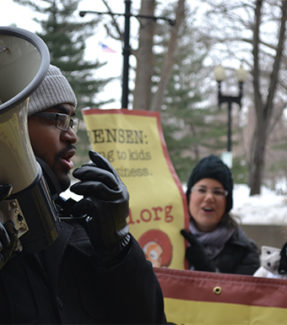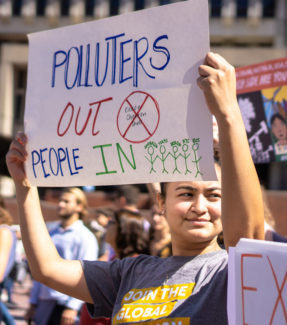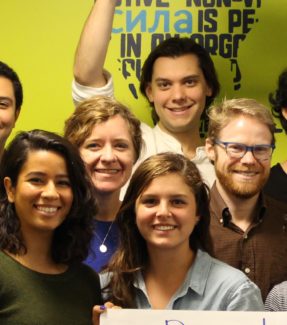1492. A year immortalized in history books around the globe. The year that European colonizers first invaded the Western hemisphere. The year that Christopher Columbus and his crew were first introduced to a plant that Indigenous people crushed up and smoked. This large green leaf went by many names in the Americas—from picietl in modern-day Mexico, to petun along the modern-day Brazilian coast—but it is best known today by English speakers as tobacco.1 Regardless of its many names, once Europeans got their first taste, they were hooked.
From that moment on, the violent history of colonization and enslavement in what is now known as the United States became intertwined with the fate of the tobacco plant. And at every step of tobacco’s development in the United States, Black people’s lives and labor have been exploited to enable its growth.
From medicine plant to European craze
Recreational smoking of tobacco gained traction among white colonists in the mid-16th century when English colonist John Rolfe began growing tobacco in the Jamestown settlement.2 Within a decade, tobacco was booming in Virginia and went from being a medicine plant to the “golden weed” of the colonies.2 Jamestown exported 2,300 pounds of tobacco to England between 1615 and 1616; by 1630, that figure rose to more than a million and a half pounds.2 Thanks to its rumored medicinal properties, including its ability to cure the plague, tobacco swept through Europe like wildfire, and its roots deepened in the North American colonies.2
Tobacco cultivation spurs plantation slavery
Tobacco is an extremely labor-intensive crop. The plantation system, and its brutal forced labor, allowed tobacco growing to flourish.3 By the end of the 17th century, demand for tobacco steadily increased while the indentured servant work force dwindled. Tobacco plantations and farmers faced a continually shrinking labor force; enslaved people from Africa unwillingly filled that demand.4 The population of enslaved Africans in the U.S. rose from an estimated 100,000 at the beginning of the 18th century to a staggering four million by the start of the Civil War.5,6It was on the backs of enslaved Black people that American agriculture grew.
In fact, the plantation system that dominated American agriculture in the 19th century grew out of tobacco cultivation. Under the burning suns of the South, enslaved people from Africa transformed the “golden weed” into a cash crop.7
Once chattel slavery ended, following the Civil War, sharecropping would fill the labor void.8 But instead of a system where laborers received fair wages for their work, sharecropping was just slavery by another name.9 A handful of white men continued to create wealth for themselves through their deadly exploitation of Black labor and lives to produce tobacco.
Birth of a deadly industry
The early 1800s saw demand switch from loose tobacco for smoking pipes and chewing tobacco to cigarettes. While tobacco use rose and fell throughout the 19th century, it would gain a new life with the invention of the cigarette rolling machine in 1880.9 This machine would allow cigarettes to be produced on a massive scale, leading to a boom in tobacco smoking and the growth of an industry. The founding of three major tobacco corporations, starting in 1847 with Philip Morris Tobacco Company, propelled the marketing and distribution of the new tobacco product.10
These tobacco corporations—two of which have modern iterations (RJ Reynolds and Philip Morris International)—and their relentless drive for profits led to the development of Big Tobacco’s infamous playbook: the menu of deadly and manipulative tactics pioneered by this industry and adopted by others like Big Polluters. In order to hook consumers and maintain growth of markets, the industry perfected tactics such as health-washing, promoting junk science, interfering in policymaking, and youth-targeted marketing. The industry became adept at side-stepping corporate accountability by widely promoting a narrative of personal responsibility and choice, all while utilizing racially targeted marketing to increase sales.11
No group was more targeted in the U.S. than Black people. The industry went from seeing Black people as a labor source, to the butt of jokes in racist advertising, to a new market to exploit. After World War II, Black people were no longer a group to be stereotyped in advertising, but instead a market the industry could forge industry-friendly relations with and target directly with its products.12 During the 1950s, tobacco giant Phillip Morris began to cultivate relationships with Black organizations such as the National Urban League, National Association for the Advancement of Colored People (NAACP), and the United Negro College Fund (UNCF) at a time when other major corporations shied away from building relationships with them.12 The result was decades of closely intertwined partnerships between tobacco giants and prominent members of the Black community. While on the surface these relationships appeared rooted in the advancement of Black communities, tobacco corporations such as Philip Morris leveraged these relationships to addict more consumers and advocate against tobacco control legislation.12,13
Throughout the 1950s and 60s, Big Tobacco began strategically targeting Black communities. Corporations like RJ Reynolds took advantage of racially segregated neighborhoods and bombarded the Black community with advertisements and promotions for menthol cigarettes, creating an entire generation of smokers addicted to its brands.14,15 In fact, U.S. national data from 2016 showed that between 74 and 88% of Black people reported smoking menthol-flavored cigarettes, compared to only 26% of white people.15
Exporting exploitation and an epidemic
The tobacco industry that we know today is a far cry from the Indigenous medicinal uses of the plant people first cultivated centuries ago. The tobacco industry is valued at $850 billion globally.16 This is equivalent the combined GDP—$852 billion—of Ukraine, Ecuador, Cuba, Slovakia, Sri Lanka, Ethiopia, Kenya, Dominican Republic, Guatemala, Oman, and Luxembourg.17
As tobacco consumption in the United States has dramatically decreased since the late 90’s, the tobacco industry has transplanted its workforce and epidemic of smoking-related diseases overseas. No longer is it exploiting people in the U.S. on the same level; instead, it’s focused on prying open the markets of countries in the Global South.18 This deadly industry continues to exploit Black labor and extract wealth from Black communities. African nations such as Malawi are dependent on tobacco—with the leaf accounting for 70% of the country’s foreign earnings.19 The country is further exploited for its workforce, where children as young as 5 work in the fields.20 The industry pays its farmers menial wages that keep them trapped in a vicious cycle of poverty, and reaps the benefits of child labor in the fields.21
Big Tobacco is one of the most powerful industries in the world. When used exactly as intended, tobacco is the only legal product designed to kill its consumer. Yet, an estimated 1.1 billion people smoke around the world.22 Only tobacco, a product so deadly, could have such a reach, and such a twisted history.
That’s why Corporate Accountability supports the work of organizations like the African American Tobacco Control Leadership Council, the Center for Black Health and Equity, and the Black Women’s Health Initiative, and joins the calls of the Black leadership that are organizing to address the racist impacts of this deadly industry. Take action with these allies today to end the sale of flavored tobacco products and demand Big Tobacco stop attempting to co-opt Black liberation movements. You can read more on Big Tobacco’s racist roots here.
Endnotes
- Kell KT. Folk Names for Tobacco. J Am Folk. 1966;79(314):590. doi:10.2307/538224
- Tobacco: The Early History of a New World Crop – Historic Jamestowne Part of Colonial National Historical Park (U.S. National Park Service). https://www.nps.gov/jame/learn/historyculture/tobacco-the-early-history-of-a-new-world-crop.htm. Accessed October 18, 2020.
- Ferrell AK. “It’s really hard to tell the true story of tobacco”: Stigma, tellability, and reflexive scholarship. J Folk Res. 2012;49(2):127-152. doi:10.2979/jfolkrese.49.2.127
- Browne-Marshall GJ. 1619 To 1819: Tell Them We Fought Back, A Socio-Legal Perspective. Phylon. 2020;57(1):37-55. doi:10.2307/26924986
- Kulikoff A. Tobacco and Slaves. University of North Carolina Press; 1986. doi:10.5149/9780807839225_kulikoff
- O’Neill A. United States: black and slave population 1790-1880 | Statista. https://www.statista.com/statistics/1010169/black-and-slave-population-us-1790-1880/. Published February 12, 2020. Accessed November 23, 2020.
- Fallin A, Glantz SA. Tobacco-control policies in tobacco-growing states: Where tobacco was king. Milbank Q. 2015;93(2):319-358. doi:10.1111/1468-0009.12124
- Crofts DW. From Slavery to Sharecropping. Rev Am Hist. 1995;23(3):458-463. doi:10.1353/rah.1995.0072
- Cummings KM, Proctor RN. The changing public image of smoking in the United States: 1964-2014. Cancer Epidemiol Biomarkers Prev. 2014;23(1):32-36. doi:10.1158/1055-9965.EPI-13-0798
- Hillstrom K. Encyclopedia of American Industries: Manufacturing Industries. 2nd ed. Detroit: Gale; 1997.
- Brandt AM. Inventing conflicts of interest: A history of Tobacco industry tactics. Am J Public Health. 2012;102(1):63-71. doi:10.2105/AJPH.2011.300292
- Yerger VB, Malone RE. African American leadership groups: Smoking with the enemy. Tob Control. 2002;11(4):336-345. doi:10.1136/tc.11.4.336
- Kong AY, Golden SD, Berger MT. An intersectional approach to the menthol cigarette problem: what’s race(ism) got to do with it? Crit Public Health. 2019;29(5):616-623. doi:10.1080/09581596.2018.1478066
- Balbach ED, Gasior RJ, Barbeau EM. R.J. Reynolds’ Targeting of African Americans: 1988-2000. Am J Public Health. 2003;93(5):822-827. doi:10.2105/AJPH.93.5.822
- Alexander LA, Trinidad DR, Sakuma KLK, et al. Why we must continue to investigate menthol’s role in the African American smoking paradox. Nicotine Tob Res. 2016;18(Suppl 1):S91-S101. doi:10.1093/ntr/ntv209
- Tobacco Market Share Analysis | Industry Report, 2020-2027. https://www.grandviewresearch.com/industry-analysis/tobacco-market. Accessed January 25, 2021.
- The World Bank. GDP (current US$) | Data. https://data.worldbank.org/indicator/NY.GDP.MKTP.CD. Published 2021. Accessed May 17, 2021.
- Bramall M, Keenlyside P. Big tobacco bullies the global south. Trade deals are their biggest weapon | Matthew Bramall and Paul Keenlyside | Opinion | The Guardian. The Guardian. https://www.theguardian.com/commentisfree/2017/jul/17/big-tobacco-trade-deals-new-markets-bat. Published July 17, 2017. Accessed April 12, 2021.
- Otañez MG, Mamudu HM, Glantz SA. Tobacco companies’ use of developing countries’ economic reliance on tobacco to lobby against global tobacco control: The case of Malawi. Am J Public Health. 2009;99(10):1759-1771. doi:10.2105/AJPH.2008.146217
- Department of Labor US. MODERATE ADVANCEMENT 1 2019 FINDINGS ON THE WORST FORMS OF CHILD LABOR.
- Otañez MG, Mamudu H, Glantz SA. Global leaf companies control the tobacco market in Malawi. Tob Control. 2007;16(4):261-269. doi:10.1136/tc.2006.019273
- Eriksen M, Mackay J, Schluger NW, Gomeshtapeh FI, Drope J. The Tobacco Atlas: Greece. 6th ed. Atlanta; 2013. http://3pk43x313ggr4cy0lh3tctjh.wpengine.netdna-cdn.com/wp-content/uploads/2015/04/TA5_FactSheet_Greece.pdf. Accessed January 26, 2021.



